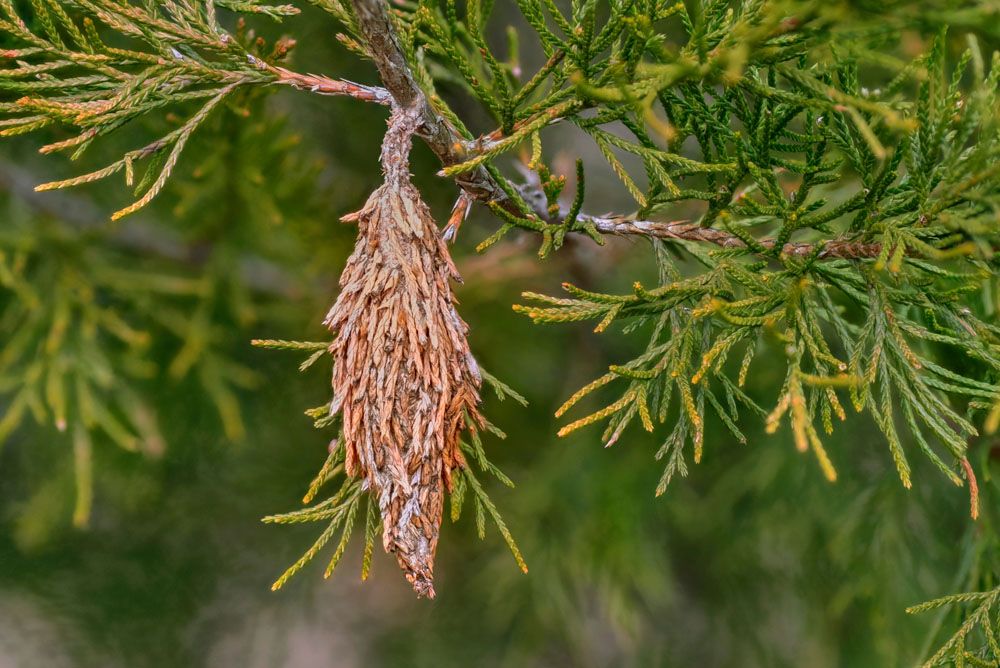
Bagworm – Thyridopteryx ephemeraeformis
Bagworm (Haworth)
This bagworm is indigenous to North America. It is found from the eastern United States to Nebraska, with the northern limit of its distribution formerly stated as southern Michigan, and in most cases at comparable latitudes. Bagworms, on the other hand, have been discovered in new regions in the recent decade, including sections of northern Michigan and southern Ontario. . It is a wingless perennial moth-like insect that lives on a variety of evergreen and juniper trees. It causes significant harm to plants and trees.
Description:
This insect is often discovered by looking at the bags formed by the larval (caterpillar) stages. Bags vary in size (up to 2 inches long and 12 inches broad) according to the larva’s growth stage (instar) and species, and their appearance changes due to the bits and pieces of host plant leaves, twigs, and bark fragments woven into the silken bag in a shingle-like pattern. Caterpillars of a few other species build bags or sacks (for example, case-bearing clothing moths and cigar case builders), but only bagworms integrate plant residues into the sacs.
Life Cycle:
Bagworm species differ slightly in their behaviors and life cycles. The bagworm spends the winter months in the egg stage within the sealed bag created by females the previous fall on evergreens. Adult males emerge with short 12 inch transparent wings, hairy black bodies, and feathery antennae. Females do not grow into moths but resemble maggots with no functional eyes, legs, mouthparts, or antennae. After mating, females die after laying a big clutch of eggs (500 to 1,000) within their bodies. Adults emerge in the spring; however, some may appear as late as October. Other bagworm species hibernate as a partly grown caterpillar over the winter. During the spring and summer, larvae of all stages feed.
Damages:
Bagworm caterpillars produce unique 1.5 to 2 inch long spindle-shaped bags that may be seen hanging from the twigs of various plants and shrubs. Bagworm caterpillars produce unique 1.5 to 2 inch long spindle-shaped bags that may be seen hanging from the twigs of various plants and shrubs. The bags are sometimes mistaken for pine cones or other plant forms. Bagworm damage could be detected by noticing rapid, dramatic changes in your evergreens. This can cause your tree to become sickly, pale, and close to death in a matter of weeks throughout the summer. Irrigation and fertilizer will not assist trees and shrubs that turn brown and shed needles or leaves. Bagworms favor juniper, arborvitae, spruce, pine, and cedar trees, although they may also attack deciduous trees.
Control:
Bagworms are difficult to eradicate because they may go undiscovered until they reach maturity. If mature larvae sense pesticides on plant leaves, they will frequently pupate early. Though there are a few recognized parasites and predators, they are frequently insufficient in urban environments.
Picking by Technical Methods:
If the bags are few and easily accessible, they can be plucked off the plant and smashed. This is simple to perform in the late fall when deciduous leaves have fallen, or the pieces of plant material on the bags have become brown and can be easily found on evergreens. Make sure to cut the connection silk band, so the branch does not become girdled in the future.
Biological Control—Use the Bacterial Spray Bt:
When applied against early larvae, Bacillus thuringiensis (Bt) is efficient against bagworms. Applications should be submitted at the end of June when all eggs have hatched and the larvae have completed their inflating.
Chemical Control:
Pesticide Sprays:
Stomach insecticides are quite effective in controlling: bagworms. Remember to fully cover the plant leaves since the larvae are shielded from touch in the silk bag. Pyrethroid insecticides (names that end in “–thrin”) are commonly used for larval control because they give rapid knock-down of tiny to big larvae.
Degree-Day Emergence-Timed Sprays:
Using a base temperature of 14.4 degrees Celsius (57.9 degrees Fahrenheit), the initial median emergence is 380 DD base 14.4 degrees Celsius (716 DD degrees Fahrenheit), and the median last emergence is 572 DD base 14.4 degrees Celsius (57.9 degrees Fahrenheit) (1062 DD degrees F). Allow for a further week of ballooning following the final emergence mark before using Bt or a pesticide. Less accurate degree-day models use a 50° F basis and calculate the last emergence at about 900 DD units.
